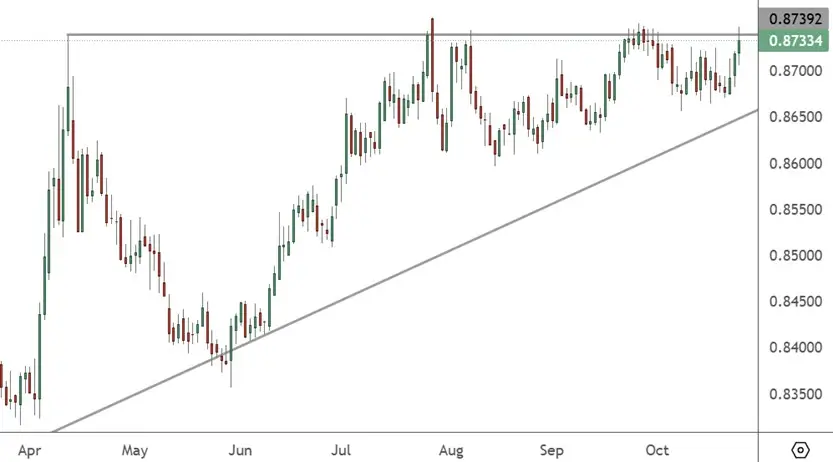The EURGBP exchange rate has tested strong resistance, but recent data was not enough for a breakout at yearly highs.

EURGBP – Daily Chart
The yearly high at 0.8737 is back in play for the EUR/GBP after some higher lows from August. That could lead to higher levels in the euro if it secures the breakout.
The UK economy released retail sales on Friday, with markets expecting a dip to -0.2%. That came in much stronger with a 0.5% reading and helped the British pound.
It’s maybe a worrying sign for the British pound to be at risk when Chancellor Rachel Reeves is set to release a November Budget in which she is expected to hike taxes or cut spending in order to close a government spending black hole of up to $50 billion.
Further bad news for the economy came with Britain’s borrowing in the first half of the financial year at its highest level on record, except for during the pandemic lockdowns.
The overshoot in borrowing during the April to September period was above official forecasts. Government borrowing in the first six months of the tax year totalled 99.8 billion pounds ($133.94 billion), up 13% from a year earlier and 7.2 billion pounds more than forecast by the country’s budget watchdog.
Analysts at ING said the Autumn Budget could be “seismic” for markets, but may push gilt yields down, rather than up. That could be from “fiscal rule changes to dubious austerity pledges – which could cause borrowing costs to spike”.
UK 10-year borrowing costs are at their highest level since a spike in September 2022, which cost the former Chancellor Liz Truss her job. “The government faces a choice. Break its election promises and raise income tax, employee NI or VAT. Politically challenging, but where small changes can raise big and predictable sums”.
Further data came from preliminary PMI data for Manufacturing and Services in Europe and Germany for October. Manufacturing in Germany remained stuck at 49.5 as expected, while the services number rose to 54.5 from 51.
The euro was not boosted by Eurozone numbers, which were also in line with market expectations as the composite figure rose from 51 to 52.2. It was the unexpected strength in the UK pound again that stopped further gains in the pair. UK manufacturing rose from 46.6 to 49.6, while the services sector readings were slightly higher at 51.1.
There is no high level data until Thursday’s European GDP figure, but traders can watch this key level into that figure.


